Save Rae’s Clestrain with actions in Orkney and the High Arctic
Arctic explorer John Rae, who died in 1893, is alive and well in the news. The BBC reported on July 5 that the Orkney Islands Council is conferring the Freedom of Orkney on that Stromness-born explorer, albeit posthumously. Bravo for that action! Here’s hoping it draws attention to the ongoing drive to fund the restoration of Rae’s childhood home, the Hall of Clestrain.
In 2014, after a relentless, ten-year campaign, Alistair Carmichael, the Scottish member of Parliament for Orkney, managed to get Rae recognized at Westminster Abbey with a modest ledger stone. Carmichael had been promised a plaque on the wall identifying Rae as the “discoverer of the final link in the first navigable Northwest Passage.” As I write in Dead Reckoning, the plaque got beaten down to a ledger stone on the floor by an anti-Rae protest, “a particularly shameful episode in a tedious tradition of repudiation that dates back to the Victorian era.”
We can return to that another day. This latest news reminded me that St. Giles Cathedral, Scotland’s answer to Westminster Abbey, has no statue of John Rae. Shouldn’t that be rectified? Then I thought of a statue of three figures which can be found in both Scotland and Canada. Near Helmsdale, it is called The Emigrants. In Winnipeg, it is The Selkirk Settlers.
Then I remembered that the famous statue of Robert the Bruce at Bannockburn was financed by a (Scottish) Canadian named Eric Harvie, who erected an identical statue in his hometown of Calgary, Alberta.
Meanwhile, I had been chatting online with Louie Kamookak, the Inuit historian and leading expert on the Franklin expedition. In 1999, Louie and I and Cameron Treleaven had placed a plaque beside the ruins of a cairn that John Rae built in 1854, marking his discovery of Rae Strait in the heart of the Northwest Passage.
Rae had been accompanied by an Inuk, William Ouligbuck, and an Ojibway, Thomas Mistegan. Without these indigenous companions — expert hunters and travelers, and the only two men who could keep up with Rae — the Orcadian explorer would not have made his crucial discovery.
Shall I cut to the chase? We need two identical statues of three figures in action: Rae, Ouligbuck and Mistegan. One of these statues could go into St. Giles . . . OR, even better, into a refurbished Hall of Clestrain. The other could go into the heart of the Arctic, to the John Rae Memorial Site on Boothia Peninsula where in 1854 Rae built his cairn.
Louie reminded me that our modest plaque probably saved the life of an Inuk who, while lost in a blizzard, had stumbled across it. Just imagine what a MASSIVE, three-person statue could do. All we need to make this happen is a present-day Eric Harvie — a no-nonsense philanthropist of vision. Yo, can anybody hear me?

